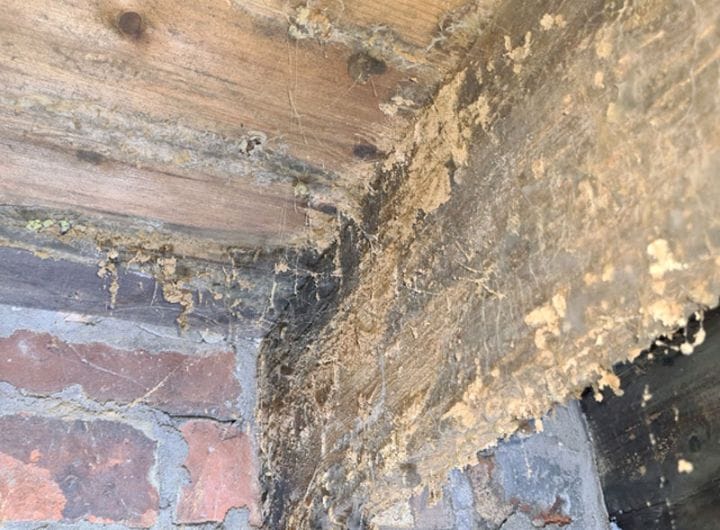woodworm
woodworm
Woodworm isn’t actually a worm – in fact, they are insects that bore into wood, causing damage to a building’s structure, its flooring and furniture. Its unlikely that you will see a woodworm in your home, however you will be able to see the devastating effects that they leave behind if left untreated.
Has Your Home Got Woodworm? We Can Help!
Woodworm is a seasonal pest, usually emerging in between the months of May and October. Woodworm left untreated can weaken timber and eventually even effect the structure of your property. If your home has been effected by woodworm, then we can help!
If you have woodworm then we can usually treat the infected areas without the use of any chemicals. However, we may use chemicals on new timber to protect it from future infestations.
Get Rid Of Woodworm Fast
Our woodworm treatment all depends on the type of infestation, but usually includes treating the area with insecticides. However, in some cases the timber may need to be replaced.
We have many years of successful experience with dealing with woodworm, not to mention a trail of happy clients. If your timber is suffering from woodworm, then don’t delay and longer. Contact our team today to arrange a consultation.

What is Woodworm?
Woodworm is the infestation of a wooden item by wood-eating larvae of many beetles. These larvae lay eggs in small cracks in your furniture, beams and floorboards. These larvae burrow into the wood, remaining there for anything up to five years, potentially causing extensive harm. The problem here is you cannot spot the larvae that cause all the damage, as the larvae rarely come to the surface during their years of eating and tunnelling through wood, it can be very difficult to spot woodworm.
However, there are a few tell tale signs which can help you find out whether your building is suffering from woodworm.
What are the common signs of woodworm?
Usually, woodworm tends to first come to light when you first start noticing the appearance of exit holes. By this point, the larva will have pupated, turned into a beetle and bored its way out of the wood. To limit any damage, it is essential to act as soon as possible when you first spot exit holes appearing. As the life of an adult beetle tends to be very short (up to four days for a male and fourteen for a female), another indication of an infestation can be the sight of dead beetles, such as on internal window ledges.
Another sign of woodworm is the presence of Frass (Bore dust) which is
left behind by woodworm beetles when they emerge from timber. There can also be tunnels within the wood caused by boring woodworm larvae. Over time, crumbling wood is caused by multiple woodworm exit holes and can be found around corners or edges of roof joists or floorboards.
How can I avoid woodworm?
The key to this is the level of moisture in your timber. All woodworm larvae prefer higher moisture content as this makes the wood easier to chew. Therefore, you should eliminate any damp patches affecting structural timbers or house furniture. It is also important to keep your home well heated
and ventilated, sealing your wood with varnish where appropriate. To avoid bringing woodworm into your house, you should always check new antique purchases for any evidence of woodworm, as well as keeping any stored firewood outdoors.
How can woodworm be treated?
Thanks to our years of experience treating woodworm in treating properties for decades, we pride ourselves on being woodworm specialists that always ensure you get the right diagnosis and treatment.
First, we begin by establishing the extent of the problem where a fully trained and experienced surveyor will inspect your home during a thorough woodworm survey. Once woodworm is confirmed, our surveyor will identify the type of beetle and the scale of the infestation in order to establish if the woodworm is active and which stage of its life cycle it is in.
Then, we will suggest appropriate treatment for your building, identifying whether there are any other repairs required (e.g. for dry rot or damp) to mitigate damage. Once agreed, our team will then carry out the specified treatments, such as using a woodworm treatment spray that kills the insects on contact. Another example of treatment is removing and replacing timber which is too damaged to be treated, especially where required structurally.
Alternatively, we can also perform resin-based repairs.
For more information about woodworm and how we can help you treat it, please do not hesitate to
get in touch with any questions you have or to get a quote.
Woodworm: Identification, Causes, and Professional Treatment
Woodworm is a common problem affecting properties across the UK, particularly in older buildings with untreated timber. Despite the name, woodworm is not actually a worm, but the larval stage of various species of wood-boring beetles. These larvae burrow through timber as they feed, causing structural damage that can become serious if left untreated.
What Is Woodworm?
Woodworm refers to the infestation of wood by the larvae of beetles such as the Common Furniture Beetle (Anobium punctatum), Deathwatch Beetle, House Longhorn Beetle, and Powderpost Beetle. These insects lay their eggs in the cracks and crevices of wooden surfaces. Once hatched, the larvae bore into the wood, feeding on it for several years before emerging as adult beetles.
The real damage occurs during this larval stage, as they tunnel through the wood, weakening it from the inside out. Infestation can affect floorboards, beams, furniture, roof timbers, and any structural timber within a building.
Signs of Woodworm Infestation
Early detection is crucial to minimise damage and cost. Here are the most common signs of woodworm:
- Tiny, round exit holes in timber, usually 1–2mm in diameter
- Fine, powdery dust (frass) near or beneath affected wood
- Tunnels within the wood, visible when timber is cut or broken
- Crumbling or weakened timber around the edges or on the surface
- Adult beetles, especially near windowsills or emerging from timber in spring and summer
- Dead beetles found near infested wood or on floors
Keep in mind that the presence of exit holes doesn’t always mean an active infestation—it could be historic. A professional woodworm survey can confirm whether treatment is required.
Causes of Woodworm
Woodworm infestations are typically caused by:
- Damp or poorly ventilated conditions, which make timber more attractive to wood-boring beetles
- Untreated or old timber, particularly in older buildings or antique furniture
- Poor maintenance, such as roof leaks or blocked vents that raise humidity levels
- Different species of beetles prefer different types of wood and environmental conditions, so it’s essential to identify the specific type of infestation to apply the right treatment.
Woodworm Treatment
Effective woodworm treatment depends on the extent of the infestation and the type of beetle involved. Standard treatment steps include:
- Professional Inspection: A timber specialist will assess the severity and determine whether the infestation is active.
- Surface Treatment: For mild infestations, a specialist insecticidal treatment is applied to the surface of the affected timber to kill larvae and prevent re-infestation.
- Injection Treatment: In severe cases, the insecticide is injected deep into the timber to eradicate burrowing larvae.
- Replacement of Damaged Timber: If structural integrity is compromised, the decayed wood may need to be replaced.
- Improve Ventilation: Reducing humidity levels will discourage future infestations.
Preventing Woodworm
- To prevent woodworm from returning:
- Keep your property well-ventilated and free from excessive moisture
- Treat any bare or untreated timber with a suitable preservative
- Store furniture and timber in dry conditions
- Regularly inspect wood in lofts, basements, and underfloor areas
Woodworm can cause serious damage if ignored, but with early identification and proper treatment, it is entirely manageable. If you suspect a woodworm problem in your home or business, contact a qualified timber treatment expert for a thorough inspection and lasting solution.
Our Accreditations



© Copyright 2024 - DLD Damp proofing Ltd
